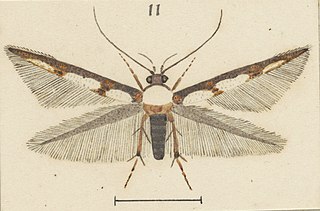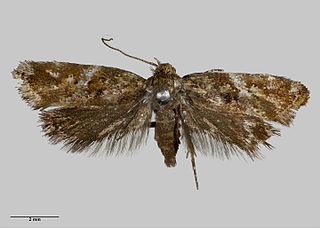
Acleris rhombana, the rhomboid tortrix, is a moth of the family Tortricidae. It is found in the Palearctic realm, from Europe to the Caucasus, Armenia, and Turkmenistan.

Sabatinca calliarcha is a species of moth belonging to the family Micropterigidae. It was described by Edward Meyrick in 1912. It is endemic to New Zealand. It is found in two separate areas of New Zealand - the first in the northern parts of the North Island including Great Barrier Island and the second population can be found from the top of the South Island down to Southland. The adults of the species are on the wing from the end of September until the middle of January. The species prefers to inhabit damp forests and larvae likely feed on leafy liverwort species. Adult moths likely feed on the spores of ferns or the pollen of sedge grasses.

Pyrgotis eudorana is a species of moth of the family Tortricidae. It is endemic in New Zealand and has been observed in both the North and South Islands. However it is regarded as a rare insect. This species inhabits native forest. Larvae exclusively feed on Muehlenbeckia australis and adults are on the wing from November to April. Adults are attracted to light.
Dichomeris carinella is a moth in the family Gelechiidae. It was described by Walsingham in 1911. It is found in Mexico (Guerrero).
Dichomeris xerodes is a moth in the family Gelechiidae. It was described by Walsingham in 1911. It is found in Mexico (Tabasco).
Dichomeris xuthostola is a moth in the family Gelechiidae. It was described by Walsingham in 1911. It is found in Mexico (Tabasco).
Dichomeris habrochitona is a moth in the family Gelechiidae. It was described by Walsingham in 1911. It is found in Panama.
Dichomeris latescens is a moth in the family Gelechiidae. It was described by Walsingham in 1911. It is found in Mexico.
Eunebristis gyralea is a moth in the family Gelechiidae. It was described by Edward Meyrick in 1922. It is found in Amazonas, Brazil.
Eunebristis zachroa is a moth in the family Gelechiidae. It was described by Edward Meyrick in 1914. It is found in Guyana.
Eunebristis zingarella is a moth in the family Gelechiidae. It was described by Walsingham in 1897. It is found in the West Indies.
Phthorimaea sphenophora is a moth in the family Gelechiidae. It was described by Thomas de Grey, 6th Baron Walsingham, in 1897. It is found in the West Indies, where it has been recorded from Grenada.
Antaeotricha walchiana is a moth of the family Depressariidae. It is found in Venezuela, Panama, Trinidad, Colombia, French Guiana, Brazil, Bolivia and Peru.
Aeolanthes ampelurga is a moth in the family Depressariidae. It was described by Edward Meyrick in 1925. It is found in northern India (Kumaon).
Cryptolechia hydara is a moth in the family Depressariidae. It was described by Lord Walsingham in 1912. It is found in Guatemala.
Psittacastis incisa is a moth in the family Depressariidae. It was described by Lord Walsingham in 1912. It is found in Mexico (Tabasco) and Panama.
Psittacastis stigmaphylli is a moth in the family Depressariidae. It was described by Lord Walsingham in 1912. It is found on Jamaica.
Hypercallia gnorisma is a moth in the family Depressariidae. It was described by Lord Walsingham in 1912. It is found in Mexico, Guatemala and Panama.

Stathmopoda aristodoxa is a species of moth in the family Stathmopodidae. It is endemic to New Zealand. It is classified as "At Risk, Naturally Uncommon" by the Department of Conservation.

Tingena eumenopa is a species of moth in the family Oecophoridae. It is endemic to New Zealand and found in the North and South Islands. The adults have been found amongst tree ferns and are on the wing in December.





